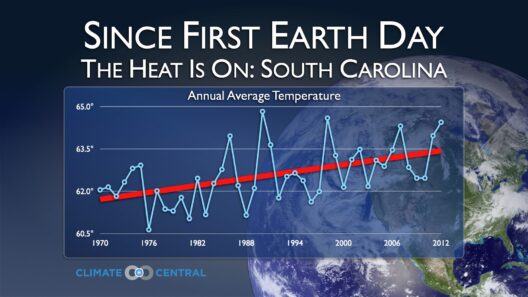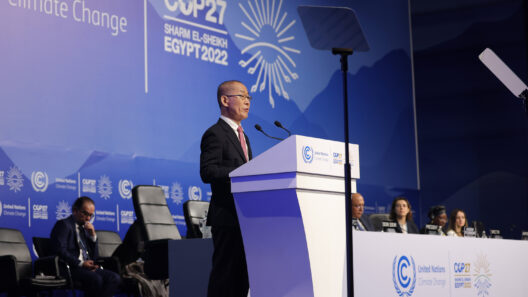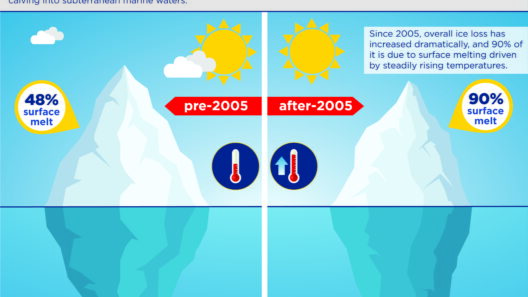Carbon, a quintessential element of life on Earth, occupies a pivotal role in the narrative of climate change. It is fundamental for organic chemistry, forming the backbone of biological molecules, yet it is also an accelerator of climate disruption when found in excess in the atmosphere. The intricate dynamics between carbon and climate change must be understood in order to appreciate the gravity of this global crisis.
The primary form of carbon responsible for climate change is carbon dioxide (CO2). This molecule is produced through a myriad of activities, ranging from the combustion of fossil fuels to deforestation. The process of burning coal, oil, and natural gas for energy generates substantial amounts of CO2. It is estimated that human activities have increased atmospheric CO2 concentrations by over 40% since the pre-industrial era, ushering in an era of unprecedented global warming.
Beyond carbon dioxide, other vital compounds, such as methane (CH4) and nitrous oxide (N2O), also exacerbate climate change. Methane, though not as prevalent as CO2, has a global warming potential that is 25 times greater over a 100-year period. This gas is predominantly released from agricultural practices, landfills, and the oil and natural gas industry. Similarly, nitrous oxide, arising from agricultural fertilizers and industrial processes, has a global warming potential approximately 298 times that of CO2, making it an equally significant player in the greenhouse gas arena.
The mechanism through which carbon dioxide and other greenhouse gases trap heat is known as the greenhouse effect. Solar radiation enters the Earth’s atmosphere, warming the surface, which then radiates heat back into space. However, greenhouse gases absorb and re-emit some of this heat, retaining it within the atmosphere and leading to a gradual increase in global temperatures. This phenomenon is critical to understanding why even slight increases in carbon concentrations can lead to substantial climatic changes.
The warming of the planet as a result of increased carbon emissions has far-reaching implications. Climate change manifests through altered weather patterns, rising sea levels, and the increased frequency of extreme weather events. Regions that were once temperate may experience scorching heatwaves, while areas prone to flooding may be inundated by heavier rains. This chaos not only disrupts ecosystems but also jeopardizes human livelihoods, particularly in vulnerable communities that lack the resources to adapt.
The ecological impact of elevated carbon levels is profound. The oceans, which absorb a significant portion of atmospheric CO2, are experiencing ocean acidification. This phenomenon adversely affects marine life, particularly organisms with calcium carbonate structures, such as coral reefs and shellfish. As these ecosystems falter, the ensuing loss of biodiversity threatens food security for millions who rely on fish and other marine resources.
Mitigation strategies are paramount to address the growing carbon dilemma. Transitioning to renewable energy sources—such as solar, wind, and hydropower—can drastically reduce greenhouse gas emissions. Additionally, enhancing energy efficiency in buildings, transport, and industry is critical. Governments and organizations must also incentivize practices that lower carbon footprints while promoting clean technologies. Carbon capture and storage (CCS) is a burgeoning field that seeks to siphon CO2 emissions from sources like power plants and securely store them underground, preventing their escape into the atmosphere.
Forestry practices play a vital role in carbon mitigation strategies. Trees sequester carbon dioxide, absorbing it from the atmosphere and storing it in their biomass. Deforestation, therefore, has a dual effect: it releases stored carbon and diminishes the Earth’s capacity to sequester atmospheric CO2. Reforestation and afforestation projects are essential for reversing this damage. Furthermore, improving agricultural practices to enhance soil carbon storage can contribute significantly to reducing atmospheric carbon levels.
The importance of legislation and international cooperation cannot be overstated in the fight against climate change. International agreements, such as the Paris Agreement, aim to unite countries in striving toward limiting global temperature rise. These efforts must be buttressed by local policies that support sustainable development, renewable energy adoption, and stringent emissions regulations. Education and public awareness campaigns play a crucial role in informing individuals and communities about how they can contribute to mitigating carbon emissions.
The intersection of technology and carbon reduction presents exciting opportunities. Innovation in battery storage, smart grids, and electric vehicles exemplifies how technology can transform energy consumption and reduce reliance on fossil fuels. Furthermore, advancements in biotechnology may yield crops that are more resilient to climate stresses and can sequester more carbon in their growth processes.
In conclusion, carbon stands as both a linchpin of life and a key instigator of climate disruption. The delicate balance of this element is under siege by anthropogenic activities that increase its atmospheric concentrations, propelling global warming and climate change. Success in mitigating these effects calls for a multi-faceted approach, integrating renewable energy, innovative technologies, reforestation, and effective policy implementation. The time for action is now; the fate of ecosystems, communities, and future generations rests in our ability to address the carbon conundrum with urgency and resolve. The continuity of life on Earth may well depend on it.







